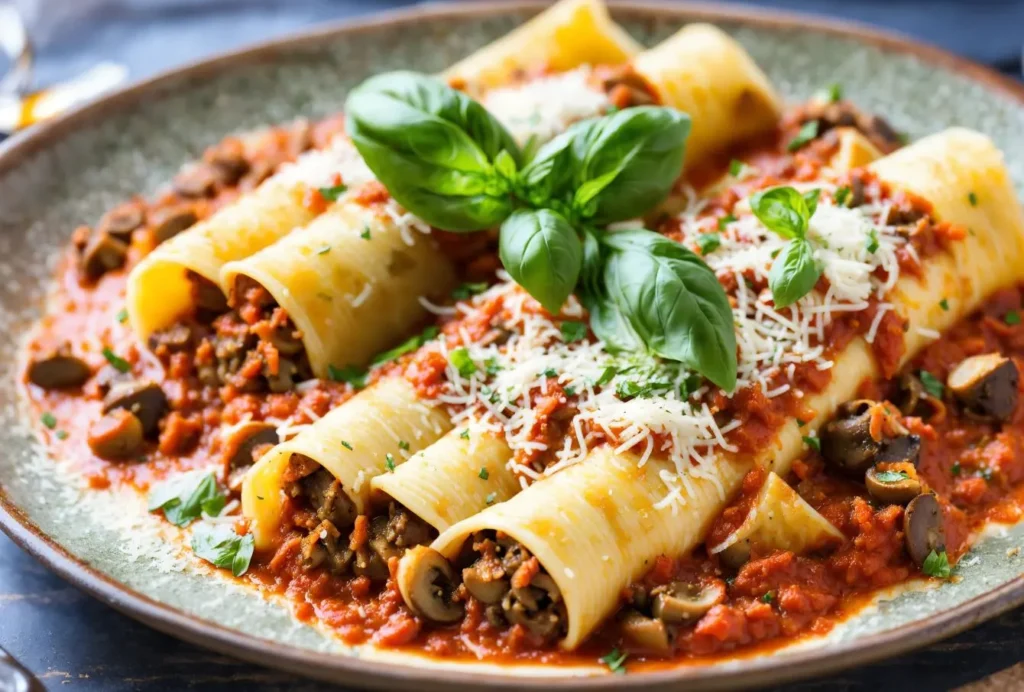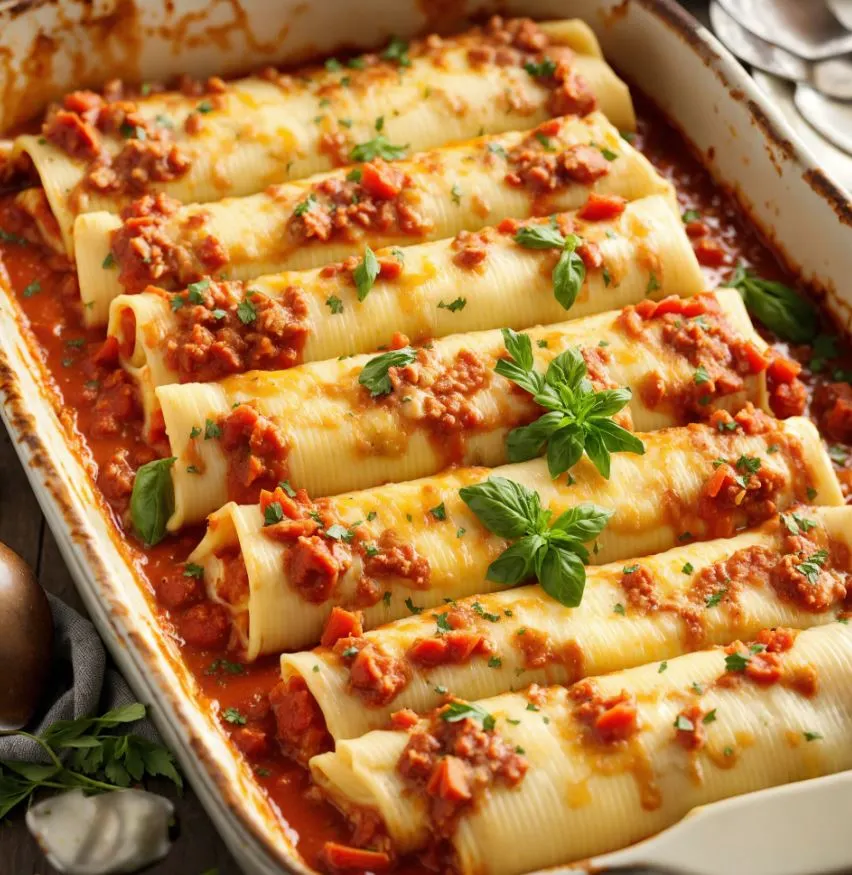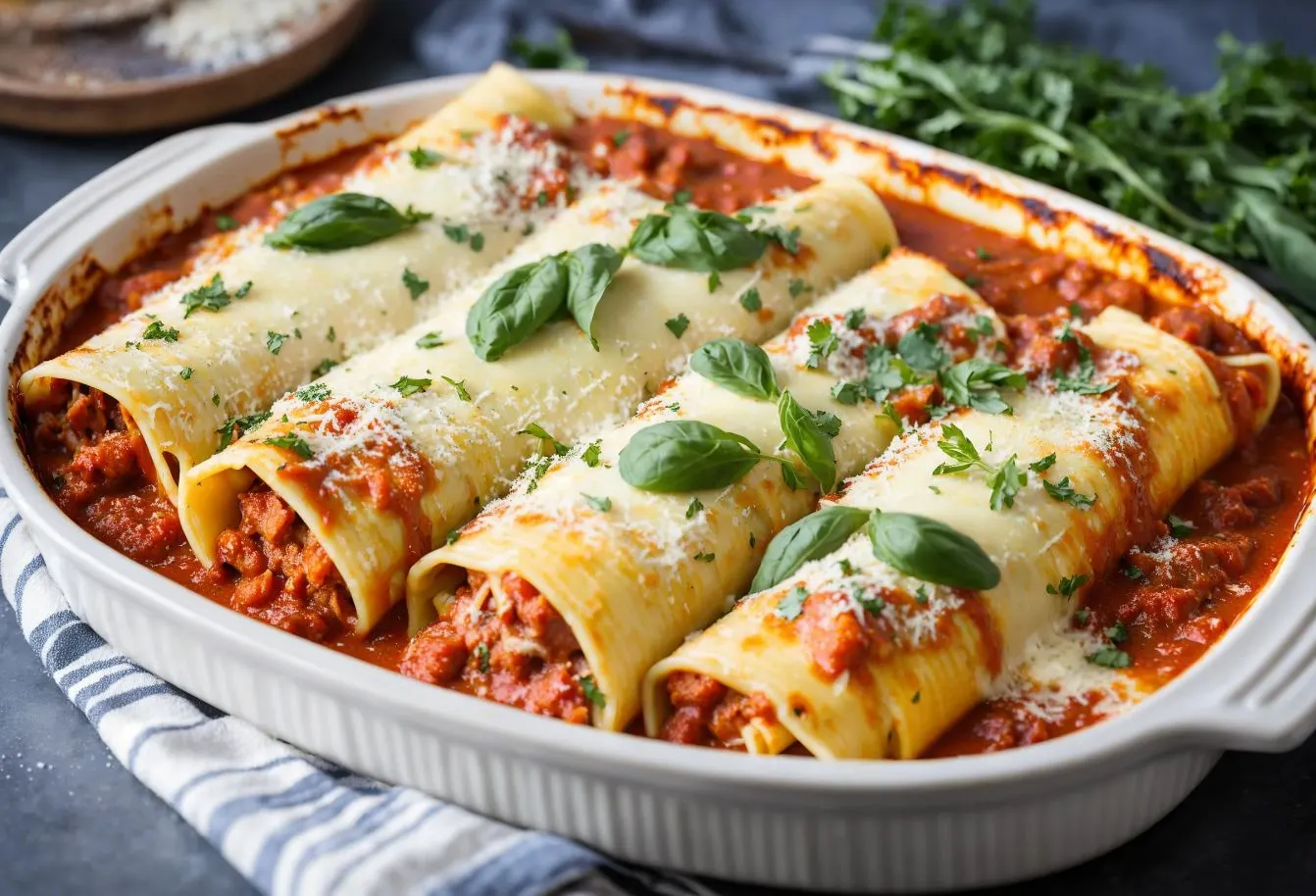Introduction to Making Manicotti Without Ricotta
Manicotti, a beloved staple in Italian cuisine, traditionally comes packed with a creamy, rich filling of ricotta cheese. However, what if I told you that the culinary world is brimming with possibilities that go beyond this classic ingredient? Yes, you heard it right! You can indeed make manicotti without ricotta cheese, and let me take you on a journey to explore these delicious alternatives.
The history of manicotti traces back to Italy, where it’s cherished for its soft pasta shells stuffed to the brim with filling, then baked to perfection. While ricotta cheese has been the heart and soul of manicotti, various reasons might prompt one to seek alternatives. Whether it’s due to dietary restrictions, texture and taste preferences, or simply the quest for something new, the world of manicotti fillings is vast and varied.
Why Avoid Ricotta?
Now, you might wonder, “Why would anyone want to skip the ricotta?” Well, for starters, dietary restrictions such as lactose intolerance or veganism make ricotta cheese a less-than-ideal choice for some. Moreover, the texture or taste of ricotta might not tickle everyone’s fancy, and sometimes, it’s about shaking things up in the kitchen, isn’t it? Additionally, depending on where you live, ricotta can be a tad on the pricey side or hard to find, pushing many to ponder over delicious alternatives.
So, buckle up as we dive into the world of manicotti without ricotta cheese, exploring a realm where taste knows no bounds, and creativity reigns supreme in the kitchen. Whether you’re a seasoned chef or a curious foodie, the alternatives we’re about to uncover will not only satisfy your palate but also add a twist to your culinary repertoire. From dairy-free delights to sumptuous cheese substitutes, the possibilities are endless, ensuring that everyone can enjoy this Italian classic, regardless of their dietary needs or preferences.
Exploring Alternative Fillings for Manicotti
Overview of Alternatives to Ricotta Cheese

Embarking on the quest for the perfect manicotti filling sans ricotta cheese unveils a treasure trove of alternatives that are just as delectable. From the creamy textures of mascarpone and cottage cheese to the robust flavors of vegan cheese alternatives, there’s a whole world out there waiting to be explored. These substitutes not only mimic the beloved characteristics of ricotta but also introduce a new dimension of taste and texture to your dish.
For those leaning towards dairy-free options, fear not! The market is awash with plant-based cheeses that offer a rich, creamy consistency ideal for stuffing your manicotti. If you’re exploring dairy-free cooking further, our article on should I defrost frozen manicotti before baking offers valuable insights into preparing frozen pasta dishes. Ingredients like cashew cheese and almond ricotta stand out as prime candidates, promising a delightful culinary experience without any dairy involved.
Recipe 1: Spinach and Cottage Cheese Manicotti
Let’s kick things off with a classic twist – a Spinach and Cottage Cheese Manicotti. This recipe marries the subtle flavors of spinach with the creamy, tangy notes of cottage cheese, creating a filling that’s both nutritious and irresistibly tasty.
Ingredients:
- Manicotti pasta shells
- 2 cups of cottage cheese
- 1 cup of chopped spinach (fresh or frozen)
- 1 egg, beaten
- Salt and pepper to taste
- Your favorite marinara sauce
- Shredded mozzarella cheese for topping
Step-by-step instructions:
- Preheat your oven to 375°F (190°C).
- In a mixing bowl, combine the cottage cheese, spinach, egg, salt, and pepper, stirring until well mixed.
- Carefully stuff each manicotti shell with the filling mixture.
- Lay the stuffed shells in a baking dish and cover them with marinara sauce.
- Sprinkle shredded mozzarella cheese generously over the top.
- Bake in the preheated oven for about 25-30 minutes, or until the cheese is bubbly and golden brown.
This dish is a testament to the fact that you can achieve mouthwatering results without sticking to tradition. For more inspiration on classic recipes with a twist, explore The Cozy Cook, where culinary creativity knows no bounds.
Recipe 2: Mascarpone and Pork Manicotti
Next up is a recipe that’s sure to tantalize the taste buds of meat lovers – Mascarpone and Pork Manicotti. This rich and savory filling combines the luxurious texture of mascarpone with the hearty flavor of ground pork, creating a dish that’s both comforting and sophisticated.
Ingredients:
- Manicotti pasta shells
- 1 cup of mascarpone cheese
- 1/2 pound ground pork, cooked and drained
- 1/4 cup grated Parmesan cheese
- 1 egg
- Salt and pepper to taste
- Marinara sauce
- Shredded Italian cheese blend for topping
Cooking method:
- Begin by preheating your oven to 375°F (190°C).
- In a bowl, mix together the mascarpone cheese, cooked ground pork, Parmesan cheese, egg, salt, and pepper until well combined.
- Stuff the manicotti shells with the pork and cheese mixture.
- Arrange the stuffed shells in a baking dish and cover with your choice of marinara sauce.
- Top with a generous amount of shredded Italian cheese blend.
- Bake for 25-30 minutes, watching as the cheese melts and turns golden, enveloping the shells in a blanket of gooey goodness.
Recipe 3: Vegan Manicotti Filling
For our friends following a plant-based diet, this Vegan Manicotti Filling is a game-changer. Utilizing the creaminess of cashew cheese and the robust flavors of nutritional yeast, this recipe ensures that everyone can enjoy the classic taste of manicotti, no dairy needed.
Ingredients:
- Manicotti pasta shells (ensure they’re vegan)
- 2 cups of homemade or store-bought vegan ricotta (cashew-based works great)
- 1/2 cup nutritional yeast for that cheesy flavor
- 1 cup of spinach, finely chopped
- Salt and pepper to taste
- Vegan marinara sauce
- Vegan cheese shreds for topping
Preparation steps:
- Preheat your oven to 375°F (190°C).
- In a bowl, combine the vegan ricotta, nutritional yeast, spinach, salt, and pepper.
- Carefully stuff the mixture into the manicotti shells.
- Place the stuffed shells in a baking dish and cover with vegan marinara sauce.
- Top with vegan cheese shreds.
- Bake for 25-30 minutes or until the dish is heated through and the cheese has melted.
Nutritional Insights: Ricotta Alternatives for Manicotti
Diving into the nutritional comparison between ricotta cheese and its alternatives can be quite the eye-opener. Ricotta, known for its creamy texture and mild flavor, also packs a nutritional punch with protein, calcium, and vitamins. However, when we pivot to alternatives like cottage cheese, mascarpone, or even vegan options like cashew cheese, the nutritional landscape shifts.
Cottage cheese, for instance, is lower in fat and calories but higher in protein, making it a fantastic option for those watching their calorie intake or seeking a protein boost. Mascarpone, on the other hand, is richer, adding a decadent texture and flavor to dishes but also increasing the calorie and fat content. Vegan alternatives, such as cashew cheese, bring a different set of nutritional benefits, including healthy fats, vitamins, and minerals, without any dairy-related allergens or cholesterol.
Mastering Manicotti: Tips for Ricotta-Free Recipes
Ah, the art of cooking manicotti! It’s not just about the filling; it’s about achieving that perfect bake, the right balance of flavors, and, of course, ensuring your pasta is cooked just right. Here are some tips and tricks to keep in your culinary toolkit:
- Choosing the Right Alternative: When picking a ricotta cheese alternative, consider the moisture content. Too dry, and your filling might be crumbly; too wet, and it could make the pasta soggy. Aim for a happy medium, like cottage cheese or well-drained cashew ricotta.
- Preventing Soggy Pasta: To avoid soggy manicotti, ensure your sauce isn’t too watery. If using a homemade sauce, let it simmer until it thickens. For store-bought sauces, choose ones labeled “thick” or “chunky.”
- Perfect Pasta Every Time: Cook your manicotti shells al dente, as they’ll continue cooking in the oven. This keeps them from turning mushy.
- Filling Made Easy: Filling manicotti shells can be a bit of a challenge. One handy trick is to put your filling into a plastic bag, snip off a corner, and pipe it into the shells, much like icing a cake.
FAQs on Making Manicotti Without Ricotta Cheese
- Can I freeze manicotti without ricotta?
- Absolutely! Just prepare your manicotti, let it cool, then cover it tightly with plastic wrap and foil. It can be frozen for up to three months. When you’re ready to enjoy, bake it straight from the freezer, adding a bit more sauce to prevent dryness.
- How do I prevent the manicotti from becoming soggy?
- Aside from not overcooking your pasta, ensure your filling isn’t too wet and that your sauce is thick enough to coat the pasta without drowning it. Baking at the right temperature (375°F) also helps evaporate excess moisture.
- What are the best sauces to complement non-ricotta fillings?
- Your sauce choice can elevate your manicotti to new heights. For lighter fillings like cottage cheese or vegan ricotta, a classic marinara works wonders. Richer fillings, such as mascarpone and pork, pair beautifully with a robust meat sauce or even a creamy béchamel. Don’t be afraid to experiment with pesto or Alfredo sauce for a unique twist!
In the realm of manicotti without ricotta cheese, the possibilities are as vast as your imagination allows. Whether you’re catering to dietary restrictions, aiming for a healthier meal, or simply in the mood to experiment, these alternatives to ricotta cheese offer a delightful way to enjoy a beloved classic. With these recipes, tips, and FAQs in your culinary arsenal, you’re well-equipped to create a manicotti masterpiece that’s sure to impress.
A Global Take on Manicotti Without Traditional Ricotta

As we’ve journeyed through the realm of manicotti without ricotta cheese, it’s clear that this Italian classic is more versatile than one might initially think. The exploration of alternative fillings not only opens the door to a world of culinary creativity but also caters to a wide array of dietary needs and preferences. From the richness of mascarpone to the healthful twist of vegan cheeses, each alternative brings its unique flavor and texture to the table, transforming the traditional manicotti into a dish that’s both familiar and excitingly new. Discover more about versatile pasta dishes in our baking manicotti guide, your ultimate resource for perfect pasta every time.
The Final Touch: Sauce Pairings and Presentation
The choice of sauce and presentation can turn your manicotti from a simple meal to a gourmet experience. Here are a few final tips to ensure your dish is as pleasing to the eye as it is to the palate:
- Sauce Pairings: Match the sauce to the filling. Lighter fillings like spinach and cottage cheese sing with a vibrant tomato basil sauce, while richer fillings such as mascarpone and pork can stand up to heartier, cream-based sauces. For an extra layer of flavor, consider adding a sprinkle of fresh herbs or a drizzle of olive oil before serving.
- Presentation: Serve your manicotti with a garnish of fresh basil or parsley to add a pop of color. A light dusting of grated Parmesan or vegan Parmesan alternative can also add both flavor and visual appeal. Remember, we eat with our eyes first, so taking a moment to plate your dish thoughtfully can elevate the dining experience.
The Cultural Significance of Manicotti
Manicotti, with its rich history rooted in Italian cuisine, is more than just a dish; it’s a cultural symbol. This section could explore how manicotti has evolved over the years, from its humble beginnings in Italian kitchens to its status as a beloved dish worldwide. Discuss the traditional celebrations and family gatherings where manicotti is a staple, highlighting how alternatives to ricotta cheese can make this dish more accessible and enjoyable for everyone, regardless of dietary restrictions or preferences.
Pairing Your Manicotti with the Perfect Wine
A great meal is elevated by the perfect beverage pairing, and manicotti is no exception. This section can guide readers through selecting wines that complement the flavors of their manicotti fillings, whether they’re opting for a dairy-free version or experimenting with different cheeses. From robust reds that stand up to hearty meat sauces to crisp whites that enhance the freshness of vegetable fillings, offer suggestions that will help readers turn their meal into a gourmet experience.
The Art of Making Homemade Pasta
For those looking to take their manicotti to the next level, consider adding a section on making homemade pasta. This could include a simple recipe for pasta dough, tips for rolling and shaping it into manicotti shells, and the benefits of using fresh pasta versus store-bought. Emphasize how homemade pasta can elevate the dish, making it even more special and tailored to personal taste preferences.
Sustainable Cooking: Using Leftovers in Your Manicotti
Sustainability in the kitchen is a topic of growing interest. This section could offer creative ideas for using leftover ingredients in manicotti fillings, reducing food waste while still creating a delicious meal. Whether it’s repurposing last night’s roasted vegetables or incorporating the remnants of a cheese platter, show readers how manicotti can be a canvas for sustainable cooking practices.
Interactive Cooking: Manicotti as a Family Activity
Cooking can be a wonderful way to spend time with family, and manicotti, with its various steps from filling to baking, presents a perfect opportunity for an interactive cooking experience. This section can provide tips for involving family members of all ages in the cooking process, from stuffing the shells to sprinkling the cheese, turning meal preparation into a fun and engaging activity that culminates in a shared, delicious meal.
Conclusion
In the end, whether you’re a staunch traditionalist ready to dip your toes into new culinary waters or a modern food enthusiast eager for the next taste adventure, manicotti without ricotta cheese offers a canvas for creativity. This exploration into the alternatives not only broadens our appreciation for Italian cuisine but also reminds us of the joy found in customization and experimentation in the kitchen.
As we wrap up this culinary journey, remember that cooking is as much about the process as it is about the outcome. Each variation of manicotti you create is a reflection of your personal taste and the care you put into your cooking. So, the next time you’re pondering over what to cook, why not revisit the classic manicotti with a twist? After all, the best dishes are those made with curiosity, creativity, and a dash of adventure.
Happy cooking, and may your manicotti be as limitless as your imagination!
